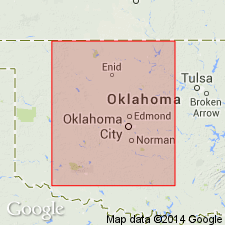
- Usage in publication:
-
- Hayward sandstone member
- Modifications:
-
- Named
- Dominant lithology:
-
- Sandstone
- Shale
- AAPG geologic province:
-
- Anadarko basin
Summary:
Named as upper member (of 2) of Garber sandstone (new) of Enid group (raised in rank); named from village of Hayward, southeastern Garfield Co, OK, Anadarko basin, where it is well exposed. Loses its identity in Grant Co, OK. No type locality designated. For the most part, consists of heavy ledges of massive red sandstone, more or less lenticular, generally cross-bedded and not uncommonly conglomeratic, interstratified with beds of fissile shale and sandy shale. In many places the sandstones weather into conspicuous cliffs. Thickness is about 350 ft. Overlies Lucien shale member (new) of Garber sandstone of Enid group; underlies Fairmont shale member (new) of Hennessey shale (new) of Enid group. Geologic map of north-central OK. Stratigraphic table. Of Permian age.
Source: GNU records (USGS DDS-6; Denver GNULEX).
For more information, please contact Nancy Stamm, Geologic Names Committee Secretary.
Asterisk (*) indicates published by U.S. Geological Survey authors.
"No current usage" (†) implies that a name has been abandoned or has fallen into disuse. Former usage and, if known, replacement name given in parentheses ( ).
Slash (/) indicates name conflicts with nomenclatural guidelines (CSN, 1933; ACSN, 1961, 1970; NACSN, 1983, 2005, 2021). May be explained within brackets ([ ]).

